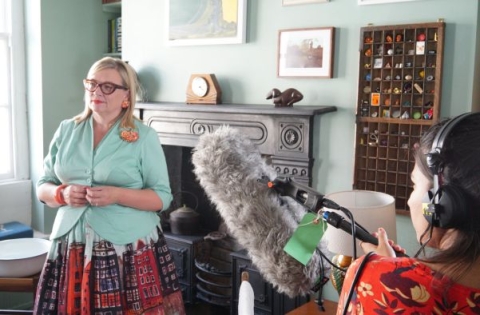
Professor Deborah Sugg Ryan from the University of Portsmouth will appear in the third series of the popular BBC factual programe, A House Through Time
The four-part documentary, which returns to our screens on Tuesday 26 May on BBC Two, tells the story of Britain’s social and political history from the 1700’s to the present day, through the residents of an Eighteenth Century sea captain’s house in Guinea Street, Bristol.
Using painstaking detective work – genealogical records, contemporary documents, and the help of expert witnesses – presenter David Olusoga uncovers the untold stories of the residents of this house from the day it was built until the present.
I am delighted to have been involved with all three series of A House Through Time as what the BBC calls a ‘super contributor’, appearing on screen and advising behind the scenes.
Deborah Sugg Ryan, Professor of Design History, University of Portsmouth
Deborah Sugg Ryan, who is Professor of Design History in the Faculty of Creative and Cultural Industries, returns in her role as the on-screen historical design and interiors expert. As the series consultant, she also advises the production company Twenty Twenty on changes in how the property might have looked and functioned through time.
Professor Sugg Ryan said: “I am delighted to have been involved with all three series of A House Through Time as what the BBC calls a ‘super contributor’, appearing on screen and advising behind the scenes. The Bristol house in series 3 posed some particular challenges to research as it is over 100 years older than those we featured previously and had undergone some significant changes. I reveal some of the objects and rituals that helped residents go about their everyday domestic lives in the house.”
Bristol was Britain’s premier slaving port through much of the 1700s, so unsurprisingly, the majority of early residents of the house had connections to the Slave Trade. But an abandoned baby, a political writer, and a dramatic sexual scandal are also discovered during these early years. The series then follows the fortunes of a wine-merchant’s son and a maid servant trapped in an abusive relationship.
I reveal some of the objects and rituals that helped residents go about their everyday domestic lives in the house.
Deborah Sugg Ryan, Professor of Design History, University of Portsmouth
Later years prove just as eventful. The late 1800s see one resident committed to the asylum suffering from terrifying delusions, and another family struggling to make ends meet during a Tuberculosis crisis. In the early Twentieth Century, the team discovers the mysterious ‘Mrs Watson’ who advertises dangerous quack remedies from the house, and investigates three sisters whose husbands fought on the battlefields of World War I.
A little more than two decades later, the street is targeted by German bombs in World War II. Professor Sugg Ryan brings to life the story of a homeless couple who find shelter in the house when their own home is destroyed. The series then traces a fraudster, and discovers a mysterious death.
By the late Twentieth Century the house is in decline, but David Olusoga finds the families who restored it to its former glory. Finally, he meets the current owners, Karen and David, and reveals the house’s extraordinary history to them.
